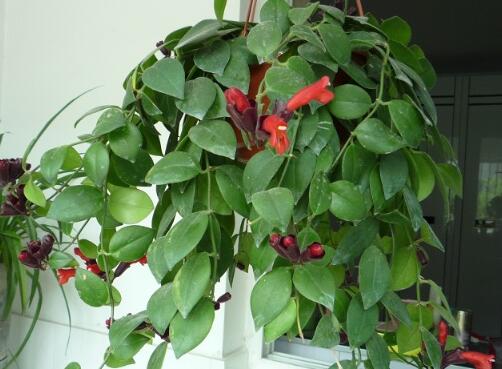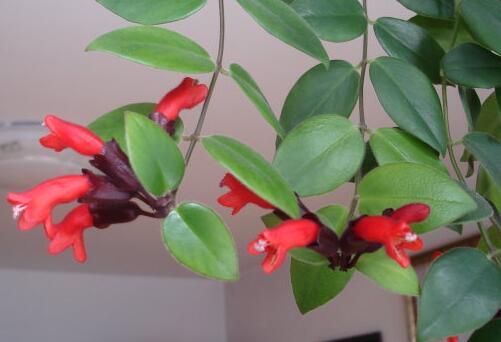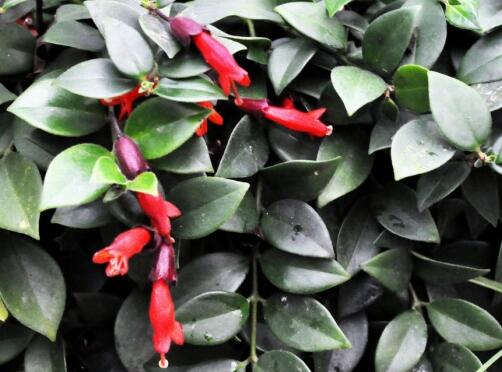How can we share our daily maintenance methods?
Lipstick orchid should apply less nitrogen fertilizer at flowering stage, improve indoor light intensity and control lower room temperature, which can promote its flowering. After the winter flowering period, the residual stems that have flowered should be cut off in time, which can save nutrients, promote new branches and make them blossom. Sometimes the top bud of lipstick hanging orchid will be necrotic for no reason, which is caused by the lack of calcium fertilizer, then appropriate amount of calcium fertilizer should be applied, and the phenomenon of top bud necrosis will disappear. Lipstick hanging orchid cuttings can live?

Lipstick hanging orchid cuttings can live:
Lipstick orchid cuttings can survive. The method of cutting can be used for planting.
The main results are as follows: 1. the suitable cutting time is spring and autumn.
2. Select strong and thick branches, cut them into 1 section every 7: 10 cm, cut them in loose sand, or culture soil prepared with serpent wood shavings 50%, perlite 20% and coarse sand 30%, maintain proper humidity and receive sunshine of about 50% and 60%. After about 30 to 40 days, the roots can grow into seedlings, and after the root groups grow vigorously, they can be planted in pots or flower beds.
3. The loose and fertile sandy loam is the best for lipstick hanging orchid basin soil, and the drainage is good. The pot soil is slightly acidic, and the pot culture soil made of peat soil, sand and vermiculite can be used, and an appropriate amount of calcium superphosphate is added.
Maintenance methods of lipstick hanging orchids:
Potted soil selection:
Lipstick hanging orchid basin soil with loose and fertile sandy loam is the best, and the drainage is good. The pot soil is slightly acidic, and the pot culture soil made of peat soil, sand and vermiculite can be used, and an appropriate amount of calcium superphosphate is added.
Suitable location:
Lipstick hanging orchid should be placed in a cool and ventilated place, and pay attention to maintain environmental humidity. Avoid continuous high temperature and humidity, poor drainage and ventilation will cause decay. Lipstick orchids are not hardy and need to be indoors in winter.
Requirements for lighting:
In a semi-overcast environment, in addition to the strong light at noon in midsummer, adequate light should be given at other times of the year, especially in winter. If the light is too strong or insufficient in the placement site, the leaves will easily become light green or yellowish green.
Watering:
The basin soil should always remain moist and avoid stagnant water in the basin, so as not to cause root rot. The water demand during the peak growth period from March to September is relatively large, so it is necessary to often water and spray to increase humidity; the autumn weather is gradually cool and cold, and the amount of water and fertilizer should be gradually reduced. The basin soil should be slightly dry in winter.
Pruning tips:
When the growth is exuberant, the heart can be properly removed to promote branching. After the winter flowering period, the residual stems that have flowered should be cut off in time, which can save nutrients, promote new branches and make them blossom.
Can sweet-scented osmanthus trees blossom and cuttings live for several years?
Sweet-scented osmanthus tree, which is very popular, because once it blossoms, it is very fragrant. How long can sweet-scented osmanthus trees blossom? Can sweet-scented osmanthus tree cuttings live?
Sweet-scented osmanthus trees can blossom in several years:
1. Under normal circumstances, it can blossom in five years.
2. Sweet-scented osmanthus is adapted to subtropical climate. Sex likes to be warm and moist. The average temperature in the planting area is 14-28 ℃, the average temperature in July is 24-28 ℃, the average temperature in January is above 0 ℃, the lowest temperature is-13 ℃, and the optimum growth temperature is 15-28 ℃. Humidity is very important to the growth and development of sweet-scented osmanthus, requiring an average annual humidity of 75% Rue 85% and an annual precipitation of about 1000 mm.
3. Sweet-scented osmanthus likes warmth and strong resistance to adversity. It is not only resistant to high temperature, but also resistant to cold.
4. sweet-scented osmanthus is not strict on soil, except alkaline soil and low-lying land or soil with too heavy viscosity and poor drainage, it can generally grow, but the slightly acidic sandy loam with deep soil layer, loose and fertile soil and good drainage is the most suitable.
Can sweet-scented osmanthus tree cuttings live:
Yes, you can. Mainly by cutting, sowing and propagation.
(1) sowing: the seeds were collected in the middle and last ten days of September, and the pericarp was dried and then stored in sand, and sown in the following spring.
(2) Cuttage: hardwood cuttage and soft wood cuttage.
A hard branches were inserted in the middle and late March, and the branches grown in the autumn of the first year were taken as cuttings with long 7~8cm, with heel, leaving 2 leaves on top and cutting depth of 1 cm 2.
B softwood cuttings were carried out in mid and late June, with strong new branches of the year as cuttings, long 7~10cm, heel, leaving 2 leaves, inserted in wet sand, and immediately set up a shade after planting.
The shading should be strict at the beginning, and the light can be gradually increased in the morning and evening after one and a half months. Rooting in 40-50 days, when there are 3-4 new leaves, thin fertilizer can be applied once, and a small plastic arch shed should be used to prevent cold during the overwintering of seedlings. It is generally kept in bed for 1 year and then transplanted in the spring of the third year.
The choice of cutting time and the control of temperature. Sweet-scented osmanthus cuttings are the best in May and June. The suitable rooting temperature of sweet-scented osmanthus is from 25 ℃ to 28 ℃. If the temperature is too low, it should be covered with plastic film to increase the light and raise the temperature of seedling bed. If the temperature is too high, you should pay attention to shading and lift a corner of the plastic film for ventilation or spray.
Cutting substrate and seedbed. Cutting substrate requires loose and permeable, good drainage, high humus content of acid soil or sandy soil, it is best to use vermiculite. A passage should be left around the seedbed and a good drainage ditch should be opened. The soil should be sterilized before insertion. A plastic arch shed with a height of 45 cm is set on the seedbed to moisturize and prevent rain and water. Build a shade shed about 1.6 meters high on the shed.
Sweet-scented osmanthus trees usually bloom for 5 years, and cuttings can be alive, do you understand?
Sharing of leaf cuttings in the process of falling flower dance cuttage
Like a warm and humid semi-overcast environment, there are requirements for a certain amount of air humidity, summer should be well ventilated, and avoid hot sun exposure. It is suitable for growing in soil which is rich in humus, loose and fertile, and has good drainage and air permeability. Today, the editor brings you the cutting process of falling Flower Dance. Let's take a look at the details.
The cuttage process of falling flower dance:
Simply and rudely insert the leaves directly into the flowerpot
Prepare a flat plate covered with vermiculite or succulent soil, put a leaf directly facing up, shade or heat, and remember not to water at this time. After sprouting for about 2 weeks, you can properly water and give the sun, but do not expose yourself to the sun.
Branch cutting
Take a leaf, do not cut the leaf nodule, insert the configured micro-tide succulent soil, wait for it to take root, you can put a small amount of rooting powder.
Put in the shade, do not expose to the sun, do not give water, and so on after budding appropriate watering, appropriate light treatment.
Whether it is leaf or branch cuttings, we should pay attention to good ventilation and appropriate humidity.
- Prev

Can lipstick orchids be raised in water? ecological habits and breeding methods
Lipstick hanging orchids like a semi-overcast environment, in addition to midsummer noon strong light should be properly sheltered, other times should be given sufficient light, especially in winter. If the light is too strong or insufficient in the placement site, the leaves will easily become light green or yellowish green. Can the lipstick orchid be raised in water? The following editor will bring you the details.
- Next

Lipstick hanging orchid leaves how to do the correct culture method to share
Lipstick hanging orchid can watch both flowers and leaves, which is very easy to survive, so it is a good plant to breed, but many friends often encounter abnormal leaves in the process of maintenance, and even lose leaves in serious cases. Lipstick hanging orchid leaves how to do? Let's take a look at the details today.
Related
- Fuxing push coffee new agricultural production and marketing class: lack of small-scale processing plants
- Jujube rice field leisure farm deep ploughing Yilan for five years to create a space for organic food and play
- Nongyu Farm-A trial of organic papaya for brave women with advanced technology
- Four points for attention in the prevention and control of diseases and insect pests of edible fungi
- How to add nutrient solution to Edible Fungi
- Is there any good way to control edible fungus mites?
- Open Inoculation Technology of Edible Fungi
- Is there any clever way to use fertilizer for edible fungus in winter?
- What agents are used to kill the pathogens of edible fungi in the mushroom shed?
- Rapid drying of Edible Fungi

